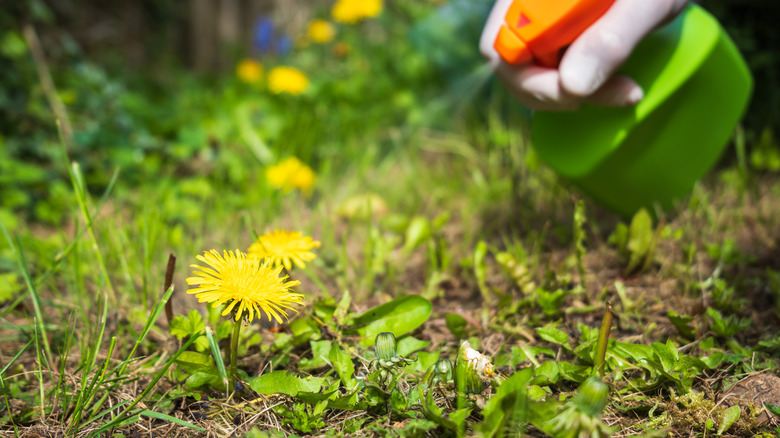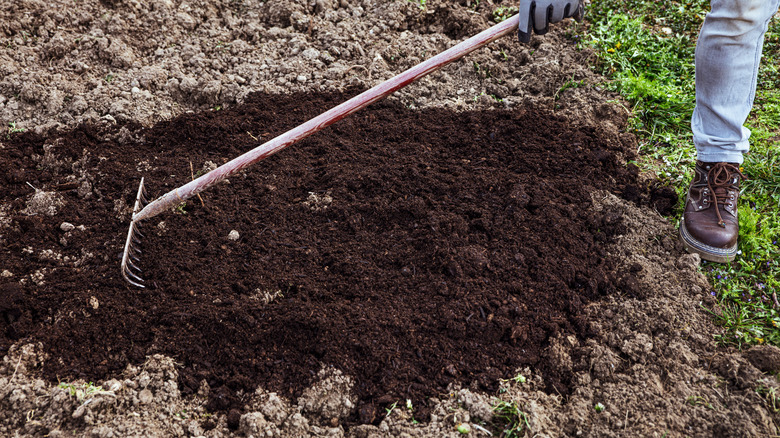Why Some Gardeners Suggest Using Dish Soap On A Lawn, And If You Should Try It
We may receive a commission on purchases made from links.
One common bottle in your kitchen might be doing more than just cutting grease on dirty plates. Many gardeners consider it a go-to secret in the world of lawn hacks, especially when it comes to killing moss and tackling weedy patches. Moss shows up in shady, damp areas of your grass and spreads if left alone, but a little bit of dish soap mixed with water and poured over problem spots may dry out moss without using any harsh chemicals. Some gardeners also try it on weeds or light lawn fungus, hoping for similar results.
While this method may be less harsh than commercial herbicides and is generally safe to use around kids or pets, it still requires patience. Weeds won't wilt overnight, and fungus won't clear up instantly either. It may take a few days or repeated applications to see a visible change. But like most home remedies, dish soap has its limits. It doesn't reach the roots, so the problem often grows back. Keep in mind that dish soap can also dry out healthy grass along with the weeds or moss, so avoid trying to spray plants with dish soap unless you're targeting a specific problem spot.
The right way to try dish soap on moss or weeds
If you're going to give this dish soap hack a shot, the key is getting the mix right and keeping your expectations in check. Start by filling a spray bottle with a mix of water and dish soap. A good ratio is about 2 tablespoons of liquid soap for every gallon of water. Stick to plain, unscented soap with minimal additives like Dawn Ultra Free and Clear to avoid unnecessary damage. Shake it well so everything mixes properly.
You'll want to spray directly on the moss or weed patches. Make sure you do it on a dry day and check the forecast. If the weather stays clear, you might see the moss start to change color within two days. Moss usually shifts from green to a dry brown-orange when it starts to die. Once that happens, rake it out and give the grass some breathing room.
For weeds, use the same dish soap solution but in a smaller batch — about 1 tablespoon of soap to a quart of water. Spray the leaves and stems directly, then leave them alone. Some people also use vinegar and salt with dish soap for a stronger effect. However, like any other homeopathic solution, always test a small area first to see how your grass reacts.
Better long-term alternatives to dish soap
Using dish soap on lawns as a hack might seem harmless, but it can still affect the environment in ways that aren't always obvious. Since it's not a natural lawn care product, it can change how your soil behaves over time. Some soaps may leave behind residues that shift pH levels or interfere with plant growth. There's also the chance of it affecting insects that play a helpful role in your yard. If you're thinking long term, it's worth looking into options that support soil health rather than disrupt it.
Since dish soap is not a durable remedy for ongoing moss issues, consider improving drainage and reducing shade to get rid of green moss and make your lawn less welcoming to it in the first place. Healthy soil is also one of the most reliable ways to keep lawn fungus and weeds in check, and compost can help get it there. Instead of treating symptoms on the surface, compost builds microbial life below it.
Natural treatments like neem oil are also worth considering. It's plant-based and targets fungal growth and pests like aphids, without damaging the grass. If you're leaning toward store-bought options, look for organic weed sprays made with ingredients like iron, citric acid, or citrus oil – like Earth's Ally fungicide lawn spray. These use natural acidity to wilt weeds without the harsh effects of dish soap. Another simpler method is to remove moss and weeds by hand or with tools like a scarifying rake or weeding knife. It takes a little effort, but it avoids putting anything extra into the soil.


